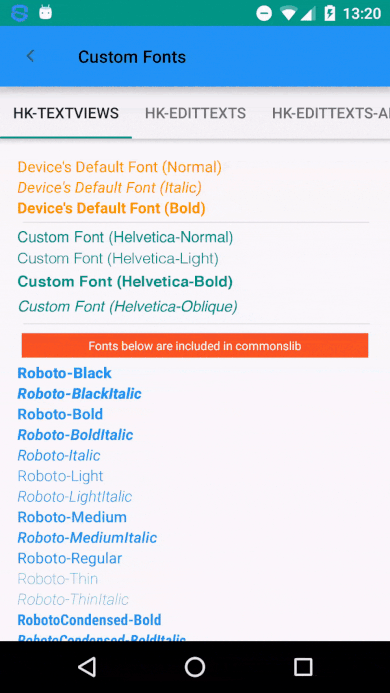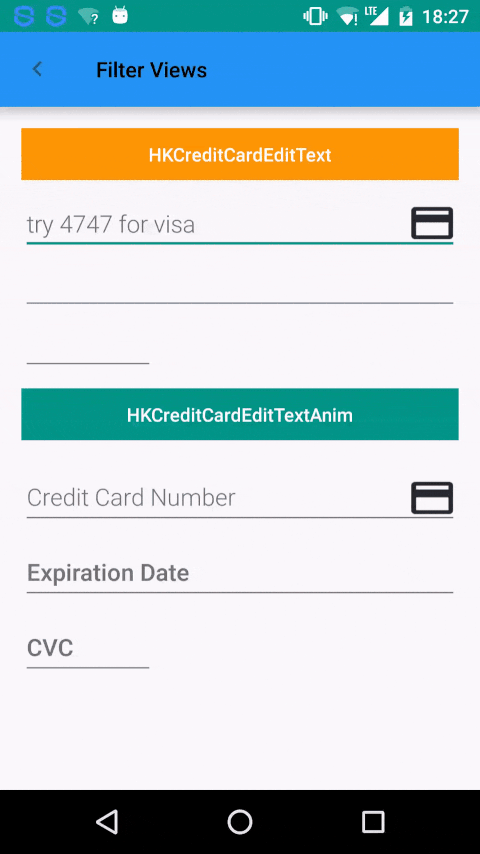Commons

Commons( commonslib) is a library containing some often used custom views
You can download demo from here
Usage:
Add jitpack.io in your root build.gradle :
allprojects {
repositories {
maven {
url "https://jitpack.io"
}
}
}
Note: do not add the jitpack.io repository under buildscript
Add the dependency in your app build.gradle :
dependencies {
compile 'com.github.hrskrs:Commons:{
releaseTag
}
'
}
Custom Views
HKTextView
A `View` extended from `AppCompatTextView`. Hence it behaves exactly same as `AppCompatTextView` itself. The only difference is that it has custom font integrated which can be used as following:By default, you should create a folder called as fonts in assets folder, and include your custom fonts (the name of custom font will be used as a parameter):
If you want to use different name for fonts folder you can do it using setFontSrcDirectory(String) setter:
myHkTextView.setFontSrcDirectory("myFontsDir");
or for subfolders:
myHkTextView.setFontSrcDirectory("myFontsDir/mySubDir");
`XML` usage:
```xml ```Setters/Getters:
//Custom Font directory/subdirectory setFontSrcDirectory(String);
String getFontSrcDirectory();
//Custom Font name setFontName(String);
String getFontName();
HKEditText
A `View` extended from `AppCompatEditText`. Hence it behaves exactly same as `AppCompatEditText`. The only difference is that you can set a custom font same as `HKEditText`.`XML` usage:
```xml ```Setters/Getters:
```java //Custom Font directory/subdirectory setFontSrcDirectory(String); String getFontSrcDirectory();//Custom Font name setFontName(String); String getFontName();
<br /> <h3> HKEditTextAnim </h3> A `View` extended from `TextInputLayout` implementing `HkEditText` as a child. Hence it behaves exactly same as `TextInputLayout` by accepting `HKEditText` parameters also. When you want to refer to `HKEditText` parameters dynamically, you must call `getHkEditText()` getter and set the parameters on it. Otherwise it will refer to the `TextInputLayout`: <h5>`XML` usage:</h5> ```xml <com.hrskrs.commonslib.views.HKEditTextAnim
android:layout_width="match_parent"
android:layout_height="wrap_content"
android:hint="Custom Font (Helvetica-Normal)"
android:textColor="@color/c_009688"
android:textColorHint="@color/c_009688"
app:hkCustomFont="Helvetica-Normal" /> /> Setters/Getters:
```java //Refering to EditText inside TextInputLayout HKEditText getHkEditText(); setHkEditText(HKEditText); ```HKCreditCardEditText
A View extended from HKEditText. Hence it behaves exactly same as HKEditText allowing setting custom font. The difference is that it is designed to work for credit card inputs. It shows an icon based on type card you type. Right now it supports VISA, MASTERCARD and APEX. As a default it show a colorless cc icon. It has three input types which can be declared through xml as hkType and a divider which can be set through hkDivider:
- `CC_NO` if the input will be Credit Card Number
- `CC_DATE` if the input will be Credit Card Date
- `CC_NO` if the input will be Credit Card CVC Number
- The divider is set as a `char`. Hence if `hkDivider` contains a string with a length greater than 1 the first char will be used as a divider. If `hkType` is set to `CC_CVC`, the `hkDivider` will be ignored.
`XML` usage:
```xml<com.hrskrs.commonslib.views.HKCreditCardEditText app:hkDivider="^" app:hkType="CC_DATE" android:layout_width="match_parent" android:layout_height="wrap_content" />
<com.hrskrs.commonslib.views.HKCreditCardEditText app:hkType="CC_CVC" android:layout_width="100dp" android:layout_height="wrap_content" />
<h5> Setters/Getters: </h5> ```java //Divider setDivider(char); char getDivider(); //Credit Card Type (0 => CC_NO, 1 => CC_DATE, 2 => CC_CVC) setCcType(int); String getCcType();
HKCreditCardEditTextAnim
A `View` extended from `TextInputLayout` implementing `HKCreditCardEditText` as a child. Hence it behaves exactly same as `TextInputLayout` by accepting `HKCreditCardEditText` parameters also. When you want to refer to `HKCreditCardEditText` parameters dynamically, you must call `getHkCreditCardEditText()` getter and set the parameters on it. Otherwise it will refer to the `TextInputLayout`:`XML` usage:
```xml<com.hrskrs.commonslib.views.HKCreditCardEditTextAnim android:layout_width="match_parent" android:layout_height="wrap_content" android:hint="Expiration Date" app:hkDivider="/" app:hkType="CC_DATE" />
<com.hrskrs.commonslib.views.HKCreditCardEditTextAnim android:layout_width="100dp" android:layout_height="wrap_content" android:hint="CVC" app:hkType="CC_CVC" />
<h5>Setters/Getters:</h5> ```java //Refering to EditText inside TextInputLayout HKCreditCardEditText getHkCreditCardEditText(); setHkCreditCardEditText(HKCreditCardEditText );References
- https://github.com/Gary111/MaskedEditText
License
Copyright (C) 2016 Haris Krasniqi Licensed under the Apache License, Version 2.0 (the "License"); you may not use this file except in compliance with the License. You may obtain a copy of the License at http://www.apache.org/licenses/LICENSE-2.0 Unless required by applicable law or agreed to in writing, software distributed under the License is distributed on an "AS IS" BASIS, WITHOUT WARRANTIES OR CONDITIONS OF ANY KIND, either express or implied. See the License for the specific language governing permissions and limitations under the License.

